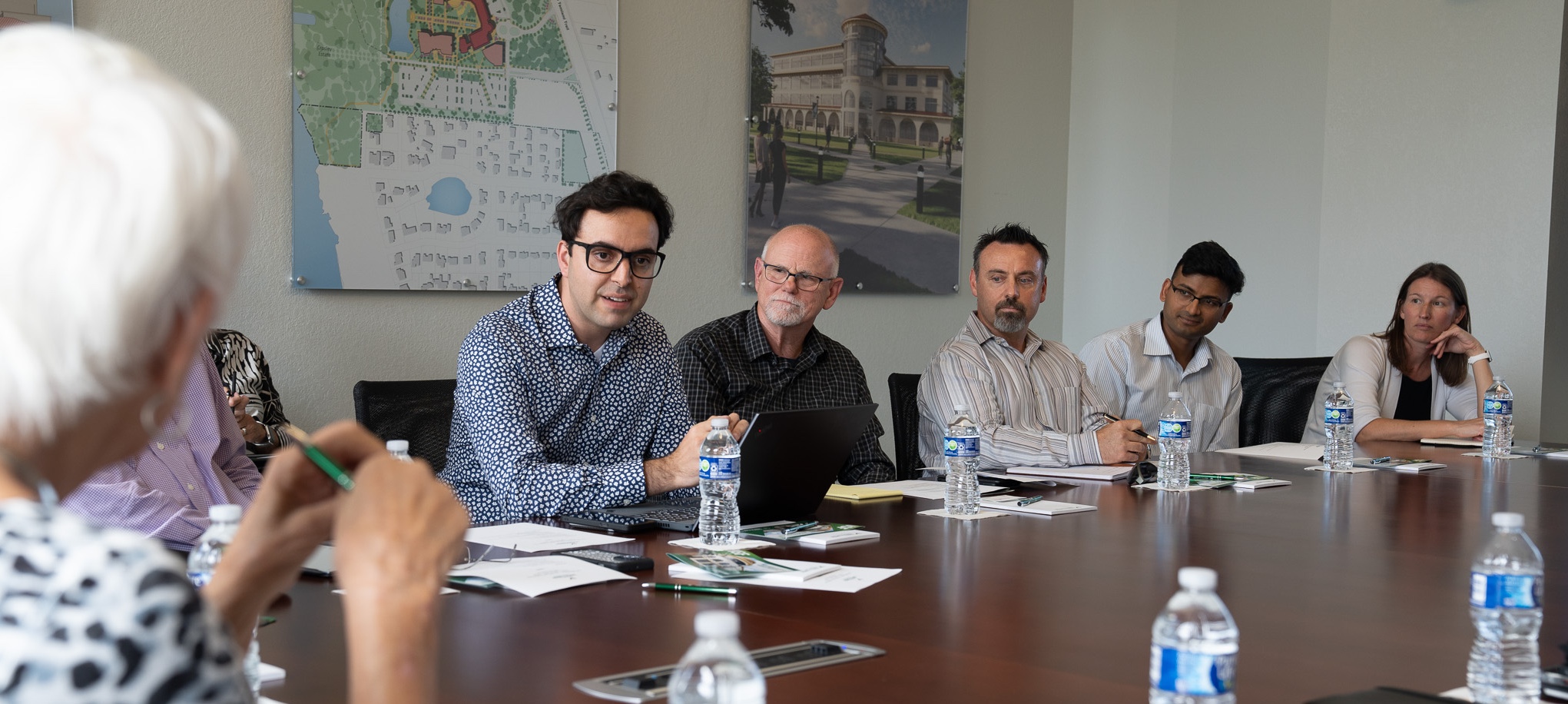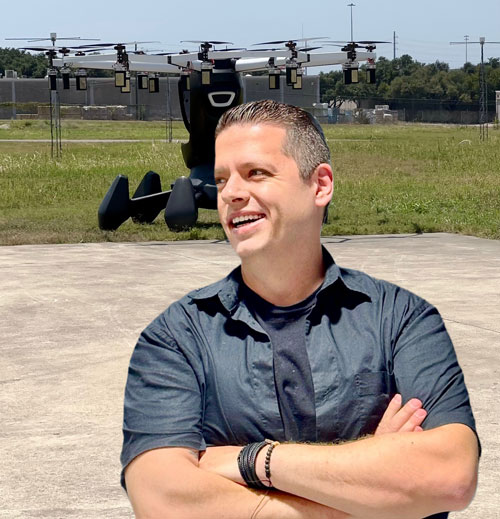An Aerospace Ecosystem Powered by Education
By William Hampton
USF Sarasota-Manatee campus students moving into the new Atala residence hall this fall were greeted with sweeping views of Sarasota Bay and a birds-eye view of the Sarasota-Bradenton International Airport (SRQ). And there is plenty of activity to observe, as it’s no secret that the airport has seen unprecedented growth in recent years.
In 2023, SRQ served 4.3 million passengers, up 12.3% from the previous year and a 215% increase since 2018 — now home to 11 airlines serving 61 destinations. Add to that, two fixed-base operators serving general and private aviation (with a third on the way) and booming flight training operations. There is always an aircraft in view from the windows of Atala Residence Hall with flight operations totaling more than 160,000 annually.
But look a little closer, and there is so much more happening on the doorstep of the Sarasota-Manatee campus, and USF seeks to play a major role in educating the highly skilled workforce that a burgeoning aerospace economy in our region demands. For students and the community alike, “the sky’s the limit.”
Florida, the birthplace of commercial aviation and the premier gateway to space, is an undisputed hub for the Americas, and a major center for flight training, aircraft maintenance and components manufacturing.
Few states can match the broad range of industry expertise available in Florida. With more than 16,000 aerospace-related companies, it ranks #2 in the U.S. for the number of aerospace establishments — employing over 130,000 people and contributing more than $19 billion in revenues to Florida’s economy.
Our area is currently home to more than 100 aviation/aerospace related companies, and we have a wealth of opportunities from expansive land options to a diverse talent pool to attract more. USF programs of all types will play an integral role in educating the highly skilled workforce needed for these companies to succeed.
Sharon Hillstrom President and CEO, Bradenton Area EDC
In the Tampa Bay region alone, there is a robust aviation and aerospace presence with more than 300 direct aerospace and defense employers — and more than 100 call the Sarasota-Manatee area home. This impressive and diverse base of local companies joined with the agility and vision of SRQ and a spectrum of educational providers in creating an aviation ecosystem like no other.
The airport along with the Bradenton Area EDC, the University of South Florida, K-12 schools and Manatee Technical College are laying the foundation to realize the vision for an aviation ecosystem. SRQ will become the only airport in the nation with a “campus” that includes: an A-rated Team Success, industry-specific charter school; an airframe and powerplant (A&P) training program being developed by the Manatee County School District in partnership with Manatee Technical College; and aerospace engineering undergraduate and graduate programs offered in the Mechanical Engineering Department at the University of South Florida.
Opportunities abound for business development and career and workforce training for
all types of students in this unique, comprehensive plan that puts education at the
center of success for the airport and local job opportunities. According to the latest
Florida Aviation Economic Impact Study, SRQ supported 23,009 direct and indirect jobs
with a payroll totaling $1 billion and overall economic impact of $3.2 billion in
2022. With more than a dozen entities involved in the ecosystem to date and continued
major announcements at the airport like the arrival of world-renowned Swiss aircraft
manufacturer Pilatus, and French company Elixir
Aircraft — it is safe to say our region is taking flight in new ways fueled by one
of the most exciting industries on the planet.
Florida is no stranger to incredible successes in the realm of aviation and aerospace. The 12 square miles of land NASA purchased in 1961 in Brevard County known as the Kennedy Space Center have launched missions to the moon and beyond, and more importantly still stand as the world center for space exploration. And make no mistake, that as the era of Advanced Air Mobility takes off, Florida will play a key role in its flight path to success. Through collaborations between institutions, industry and community, our aerospace ecosystem, with SRQ and education at its heart, will leave its mark and create opportunity locally and beyond for generations to come.

AEROSPACE ENGINEERING AT USF DRIVING RESEARCH, INNOVATION AND OPPORTUNITIES FOR STUDENTS
The University of South Florida through the Department of Mechanical Engineering is establishing a world-class Aerospace Engineering program to meet the challenges and opportunities of the evolving aerospace sector. Employment is growing at 6%, larger than the average for all occupations according to U.S. Bureau of Labor Statistics. Only a handful of schools in Florida offer degree programs in aerospace engineering, and the University of South Florida is actively working to meet workforce demands in this vital field.
In addition to growth, the industry is on the brink of transformative changes driven by new technologies. From the integration of AI and machine learning that will optimize operations and enhance safety, to the implementation of VR/AR into pilot training and Advanced Air Mobility — “the third major revolution in aerospace.”
We saw an opportunity that matched well with our state, region, faculty expertise, research areas and opportunities for students. Aerospace Engineering at USF will open up tremendous potential for our institution to be involved on the forefront of technological developments across a range of disciplines and applications.
Rajiv Dubey, Professor and Mechanical Engineering Department Chair
Aerospace Engineering coursework began last fall with solid enrollment and positive
student feedback. This fall, a minor in aerospace engineering was launched with plans
to add abachelor's, master's and doctoral degrees in aerospace engineering. The graduates
of these programs will contribute to the continued advancement of the aerospace ecosystem
regionally and beyond.
The department has been busy securing equipment and onboarding an impressive slate
of faculty that will lead and shape the new program. They come to USF eager to apply
their experience and expertise across several areas including network control systems,
bio-inspired aerodynamics, aero acoustics, experimental fluid mechanics, autonomous
vehicles, cybersecurity, and even designing and building wind tunnels.
And the faculty already boasts a solid portfolio of research approaching around $5M annually. Primarily through NASA and the U.S. Department of Defense in the areas of acoustics and noise control, aerodynamics, space exploration, urban air mobility, flight control, propulsion, hypersonic flows and advanced materials and manufaturing.
USF – Leading the Charge in Advanced Air Mobility (AAM)

USF Associate Professor Tansel Yucelen
The first revolution in aviation began with the Wright brothers' successful powered flight, forever extending the reach of humanity. The second revolution came with jet propulsion, transforming global mobility by allowing people to travel across the world at unprecedented speeds. Now, we are witnessing the third major revolution in aerospace: one that promises to reshape urban mobility, disaster response and product delivery through rapid and efficient air travel across short distances. This third revolution, driven by the development of electric aircraft collectively referred to as Advanced Air Mobility (AAM), is set to redefine personal aerial travel. Concepts like “flying cars,” air taxis and other emerging innovations are no longer the realm of science fiction but are becoming a tangible reality.
At the forefront of this transformation is the University of South Florida, led by Associate Professor Tansel Yucelen, who is also the Director of the Laboratory for Autonomy, Control, Information and Systems (LACIS). USF is pioneering AAM research and development with the acquisition of the Lift Hexa, making it the first public university to possess a full-scale manned VTOL (Vertical Take-Off and Landing) vehicle. This milestone positions USF as a leader in advanced aerospace research, with a particular focus on autonomous control systems, urban air mobility and safety.

VTOL (Vertical Take-Off and Landing) vehicle
Professor Yucelen explains that the Hexa is designed for two main purposes: transporting a single passenger via vertical takeoff and landing from rooftops or remote areas, and cargo delivery. Looking ahead, he envisions that within the next 10 to 20 years, these “flying cars” will move beyond novelty and become an integral part of daily life.